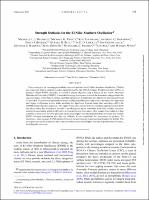Mostrar el registro sencillo del ítem
Strength outlooks for the El Niño-Southern Oscillation
| dc.contributor.author | L'Heureux, M.L. | |
| dc.contributor.author | Tippett, M.K. | |
| dc.contributor.author | Takahashi, Ken | |
| dc.contributor.author | Barnston, A.G. | |
| dc.contributor.author | Becker, E.J. | |
| dc.contributor.author | Bell, G.D. | |
| dc.contributor.author | Di Liberto, T.E. | |
| dc.contributor.author | Gottschalck, J. | |
| dc.contributor.author | Halpert, Michael S. | |
| dc.contributor.author | Hu, Zeng-Zhen | |
| dc.contributor.author | Johnson, Nathaniel C. | |
| dc.contributor.author | Xue, Yan | |
| dc.contributor.author | Wang, Wanqiu | |
| dc.date.accessioned | 2019-07-28T17:01:48Z | |
| dc.date.available | 2019-07-28T17:01:48Z | |
| dc.date.issued | 2019-02 | |
| dc.identifier.uri | https://hdl.handle.net/20.500.12542/102 | |
| dc.description.abstract | Three strategies for creating probabilistic forecast outlooks for El Niño-Southern Oscillation (ENSO) are compared. One is subjective and is currently used by the NOAA/Climate Prediction Center (CPC) to produce official ENSO outlooks. A second is purely objective and is based on the North American Multimodel Ensemble (NMME).Anew third strategy is proposed in which the forecaster only provides the expected value of the Niño-3.4 index, and then categorical probabilities are objectively determined based on past skill. The new strategy results in more confident probabilities compared to the subjective approach and higher verification scores, while avoiding the significant forecast busts that sometimes afflict the NMME-based objective approach. The higher verification scores of the new strategy appear to result from the added value that forecasters provide in predicting the mean, combined with more reliable representations of uncertainty, which is difficult to represent because forecasters often assume less confidence than is justified. Moreover, the new approach can produce higher-resolution probabilistic forecasts that include ENSO strength information and that are difficult, if not impossible, for forecasters to produce. To illustrate, a nine-category ENSO outlook based on the new strategy is assessed and found to be skillful. The new approach can be applied to other outlooks where users desire higher-resolution probabilistic forecasts, including the extremes. | en_US |
| dc.format | application/pdf | |
| dc.language.iso | eng | en_US |
| dc.publisher | American Meteorological Society | en_US |
| dc.relation.ispartof | urn:issn:0882-8156 | |
| dc.rights | info:eu-repo/semantics/openAccess | |
| dc.rights | Atribución-NoComercial-SinDerivadas 3.0 Estados Unidos de América | * |
| dc.rights.uri | http://creativecommons.org/licenses/by-nc-nd/3.0/us/ | * |
| dc.source | Servicio Nacional de Meteorología e Hidrología del Perú | |
| dc.source | Repositorio Institucional - SENAMHI | |
| dc.subject | Climate prediction | en_US |
| dc.subject | ENSO | en_US |
| dc.subject | Forecast verification/skill | en_US |
| dc.subject | Operational forecasting | en_US |
| dc.title | Strength outlooks for the El Niño-Southern Oscillation | en_US |
| dc.type | info:eu-repo/semantics/article | |
| dc.identifier.isni | 0000 0001 0746 0446 | |
| dc.description.peerreview | Por pares | |
| dc.identifier.doi | https://doi.org/10.1175/WAF-D-18-0126.1 | |
| dc.source.issue | 34 | en_US |
| dc.source.issue | 1 | en_US |
| dc.source.initialpage | 165 | en_US |
| dc.source.endpage | 175 | en_US |
| dc.source.journal | Weather and Forecasting | en_US |
| dc.subject.sinia | fenomeno El Niño - Clima y Eventos Naturales | |
| dc.type.sinia | text/publicacion cientifica | |
| dc.identifier.url | https://hdl.handle.net/20.500.12542/102 |
Ficheros en el ítem
Este ítem aparece en la(s) siguiente(s) colección(es)
-
Artículo científico [171]








